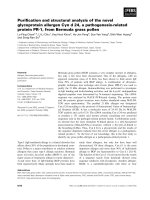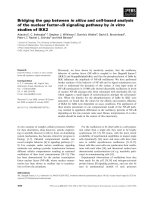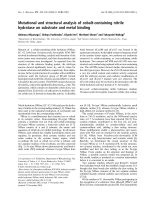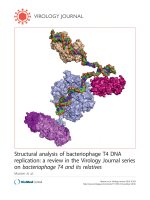CRYSTALLISATION AND PRELIMINARY STRUCTURAL ANALYSIS OF ECM18 WHICH CATALYSES DISULFIDE TO THIOACETAL CONVERSION IN ECHINOMYCIN BIOSYNTHESIS
Bạn đang xem bản rút gọn của tài liệu. Xem và tải ngay bản đầy đủ của tài liệu tại đây (3.87 MB, 79 trang )
CRYSTALLISATION AND PRELIMINARY STRUCTURAL
ANALYSIS OF ECM18 WHICH CATALYSES DISULFIDE TO
THIOACETAL CONVERSION IN ECHINOMYCIN
BIOSYNTHESIS
SOUMYA RANGANATHAN
NATIONAL UNIVERSITY OF SNGAPORE
2012
CRYSTALLISATION AND PRELIMINARY STRUCTURAL
ANALYSIS OF ECM18 WHICH CATALYSES DISULFIDE TO
THIOACETAL CONVERSION IN ECHINOMYCIN
BIOSYNTHESIS
SOUMYA RANGANATHAN
(B.Tech., A.C. College of Technology, Anna University, Chennai,
India)
A THESIS SUBMITTED
FOR THE DEGREE OF MASTER OF SCIENCE
DEPARTMENT OF BIOLOGICAL SCIENCES
NATIONAL UNIVERSITY OF SNGAPORE
2012
Acknowledgements
I would like to express my deepest gratitude and sincere thanks to my supervisor,
Assistant Professor Kim Chu-Young, for his continuous guidance and support during the past
two years of my research project.
I would like to thank our lab’s postdoctoral research fellow Dr. Kinya Hotta for his
advice and critical suggestions through the various stages of my research work.
I would like to extend my special thanks to my pre-thesis committee members –
Associate Professor J Sivaraman and Associate Professor Henry Mok for their valuable
suggestions and feedback.
Also, I would like to thank our collaborator Kenji Watanabe for providing the Ecm18
gene for carrying out this project.
I would like to thank my friend and lab mate Fang Minyi, for the valuable discussions
and suggestions in understanding the mechanism of the enzyme.
I would like to thank my fellow graduate students, lab mates and friends for the
pleasant learning experience I had at NUS. Particularly, I am thankful to Priya Jayaraman,
Roopsha Brahma, Fang Minyi, Sindhuja, Srinath, Lavanya, Jeremy, Satyadev and Alvin for
their support, advice, suggestions and encouragement.
I am deeply grateful to my parents in India for their support and love during the
difficult times.
Finally, I am thankful to NUS for offering me the research scholarship and the
valuable opportunity for the postgraduate study.
i
Table of Contents
Acknowledgements ................................................................................................................... i
Summary ................................................................................................................................... v
List of Tables ..........................................................................................................................vii
List of Figures ....................................................................................................................... viii
List of Abbreviations ............................................................................................................... x
Chapter 1 Introduction............................................................................................................ 1
1.1 Nonribosomal peptides ..................................................................................................... 2
1.1.1 Nonribosomal peptide synthesis ................................................................................ 3
1.2 Quinomycin antibiotics .................................................................................................... 4
1.3 Echinomycin..................................................................................................................... 4
1.3.1 Biosynthesis of echinomycin ..................................................................................... 5
1.3.2 Importance of thioacetal bridge ................................................................................. 6
1.4 SAM dependent methylation ............................................................................................ 8
1.4.1 Different mechanisms of methyl transfer .................................................................. 9
1.4.2 Structural basis for methyl transfer by SAM-dependent MTases – Rossman fold
and TIM barrels .................................................................................................................. 9
1.4.3 Rossmann-like fold facilitates nucleophilic substitution ........................................... 9
1.4.4 TIM barrel fold facilitates free radical formation .................................................... 11
1.5 Bioinformatics analysis .................................................................................................. 13
1.5.1 Secondary structure prediction ................................................................................ 15
ii
1.5.2 Homology modelling ............................................................................................... 16
1.5.3 Sequence comparison with homologous proteins ................................................... 16
Research Objectives ............................................................................................................... 18
Chapter 2 Materials and Methods........................................................................................ 19
2.1 Cloning of Ecm18 gene .................................................................................................. 20
2.2 Expression of recombinant protein ................................................................................ 20
2.3 Purification of recombinant Ecm18 ............................................................................... 21
2.4 Protein confirmation by MALDI TOF-TOF analysis .................................................... 24
2.5 Protein Characterisation ................................................................................................. 25
2.5.1 Circular Dichroism (CD) spectroscopy ................................................................... 25
2.5.2 Dynamic Light Scattering (DLS) ............................................................................ 26
2.6 Protein crystallisation ..................................................................................................... 28
2.7 X-Ray data collection ..................................................................................................... 32
2.8 Phase determination and model building ....................................................................... 33
2.9 Refinement ..................................................................................................................... 34
Chapter 3 Results and Discussion ........................................................................................ 36
3.1 Quality of the structure................................................................................................... 37
3.2 Overview of the structure ............................................................................................... 37
3.3 Conserved Rossmann-like fold / SAM-binding domain ................................................ 40
3.3.1 Conserved motifs involved in SAM/SAH binding .................................................. 40
3.4 Substrate binding domain ............................................................................................... 41
iii
3.5 Conformation of echinomycin in Ecm18 ....................................................................... 43
3.6 Elucidation of the mechanism of action of Ecm18 ........................................................ 45
3.6.1 Methylation by nucleophilic attack ......................................................................... 46
3.6.2 Putative catalytic residues in Ecm18 ....................................................................... 48
3.7 Multiple Sequence alignment of Ecm18 with small molecule MTases ......................... 51
Chapter 4 Conclusion and Future work .............................................................................. 53
4.1 Conclusion...................................................................................................................... 54
4.2 Future work .................................................................................................................... 55
References ............................................................................................................................... 56
Appendices .............................................................................................................................. 61
iv
Summary
The present work is a structure-function study of an enzyme Ecm18 involved in the
biosynthesis of an antibiotic and antitumor compound called echinomycin. Apart from
possessing antitumor activity, echinomycin is known for its remarkable pharmaceutical
properties.
Echinomycin belongs to a large family of complex natural products called nonribosomal
peptides (NRPs). One of the most important subfamily of NRPs is the family of compounds
called quinomycins. Quinomycin group of compounds possess potent antiviral, antibacterial
and antitumor properties. They are DNA-intercalating agents and are characterised by the
presence of a unique chemical group called the thioacetal group. The presence of this
chemical group provides better stability to the quinomycins over other closely related
compounds. It is because of this reason the quinomycins have become important
pharmaceutical drug candidates.
Echinomycin is a member of this very remarkable class of compounds. It has antibacterial
and antitumor properties and has recently gained prominence as an important antitumor drug
candidate.
In a recent investigation carried out in 2006 (Watanabe K 2006), the complete biosynthetic
pathway of echinomycin was uncovered in the bacterium Streptomyces lasaliensis. Here they
have made an interesting discovery that the final step in the biosynthetic pathway of
echinomycin involves an unprecedented biotransformation (disulfide bond to thioacetal
group) in which methylation and subsequent bond rearrangement lead to the formation of
echinomycin. They found that a single enzyme was responsible for this unique conversion
which was later identified to be Ecm18.
v
Ecm18 is the first reported natural enzyme, to catalyse this unique biotransformation. It has
39% sequence identity with a known methyltransferase. But other details regarding this
protein could not be obtained from the available sequence information. In order to get a
detailed understanding of the catalytic mechanism of this enzyme, we sought to study its
structure using X-ray crystallography.
Ecm18 protein was heterologously expressed in E.coli system and purified for the purpose of
crystallisation. The enzyme was successfully captured in its crystallised form in complex
with its product and by-product and a high-resolution (1.5 Å) diffraction dataset was
collected for the crystal. The structure of the ternary complex was determined from the
diffraction data and it is currently being refined.
With the partially refined structure, we have made preliminary investigations regarding the
architecture of the enzyme. Ecm18 possesses a well conserved Rossmann-like fold found in
many methyltransferases, whereas its substrate binding domain is not conserved. Apart from
the structural information obtained, an interesting observation was made from the ternary
complex structure. Echinomycin in complex with the enzyme Ecm18 has a folded
conformation whereas in the previously determined structures of echinomycin (echinomycin
in complex with oligonucleotides), it is in an extended conformation.
We have also identified the putative residues of Ecm18 that are involved in catalysis. Based
on the observations and interpretations, we propose a plausible catalytic mechanism of
Ecm18. The presence of Rossmann-like fold and the linear arrangement of product and byproduct indicate methyl transfer by nucleophilic attack. His-115 has been identified as a
putative catalytic base involved in a proton abstraction step. Two aromatic residues Phe-5 and
Trp-21 have been identified to have plausible role in catalysing an important step in the
biotransformation. Further studies must be carried out to confirm the proposed mechanism.
vi
List of Tables
Table 1. X-ray data collection statistics for Ecm18 ................................................................ 32
Table 2. Refinement statistics for Ecm18 ................................................................................ 35
vii
List of Figures
Figure 1. Examples of nonribosomal peptide natural products. ................................................ 2
Figure 2. Nonribosomal peptide synthesis involving multienzyme complex machinery .......... 3
Figure 3. Structure of echinomycin. It is a cyclic peptide (NRP) .............................................. 5
Figure 4. Biosynthetic pathway of echinomycin in Streptomyces lasaliensis. .......................... 6
Figure 5. Comparison of the structures of triostin A and echinomycin ..................................... 7
Figure 6. S-Adenosyl methionine (SAM). ................................................................................. 8
Figure 7. Rossmann-like fold in SAM-dependent methyltransferases (MTases) .................... 10
Figure 8. Methyl transfer by nucleophilic substitution ............................................................ 11
Figure 9. TIM barrel fold in radical SAM enzymes ................................................................ 12
Figure 10. Methyl transfer through the formation of free radical intermediate ....................... 12
Figure 11. Ecm18 sequence analysis using PfamA domain prediction. .................................. 13
Figure 12. Ecm18 sequence analysis using NCBI conserved domain database (NCBI-CDD)
.................................................................................................................................................. 14
Figure 13. Secondary structure prediction for Ecm18 ............................................................. 15
Figure 14. Homology model of Ecm18 ................................................................................... 16
Figure 15. Multiple sequence alignment of Ecm18 with structurally close homologues ........ 17
Figure 16. Ecm18 protein purification – Nickel affinity purification and anion exchange
chromatography ....................................................................................................................... 23
Figure 17. Ecm18 protein purification – Size exclusion chromatography .............................. 24
Figure 18. CD spectra of purified Ecm18 ................................................................................ 25
Figure 19. Dynamic Light Scattering profile of Ecm18 .......................................................... 27
Figure 20. Chemical structures of SAM, SAH and Sinefungin. .............................................. 28
Figure 21. Images of crystals obtained for Ecm18 - echinomycin- SAH complex. ................ 30
Figure 22. Optimisation of Ecm18 crystals ............................................................................. 31
viii
Figure 23. Fo – Fc electron density map (contoured at 3 σ) of the region surrounding Asp-169
and Asp-170. ............................................................................................................................ 34
Figure 24. Ecm18-echinomycin-SAH ternary complex .......................................................... 38
Figure 25. Structural overlay of Ecm18 with close homologues predicted from DALI.......... 39
Figure 26. Rossmann-like fold conserved in Ecm18 ............................................................... 41
Figure 27. Region of echinomycin-Ecm18 interaction ............................................................ 42
Figure 28. Conformational change in echinomycin ................................................................. 44
Figure 29. Proposed mechanism of action of Ecm18 in the conversion of triostin A to
echinomycin.. ........................................................................................................................... 46
Figure 30. Relative orientation of substrate and cofactor in Rossmann-like fold MTases ...... 47
Figure 31. Histidine 115 - putative catalytic base.................................................................... 49
Figure 32. Putative residues of Ecm18 involved in transition state stabilisation .................... 50
Figure 33. Multiple sequence alignment of Ecm18 with structurally characterised small
molecule MTases ..................................................................................................................... 51
ix
List of Abbreviations
CD
Circular dichroism
DLS
Dynamic light scattering
DNA
Deoxyribonucleic acid
DTT
Dithiothreitol
E. coli
Escherichia coli
EDTA
Ethylenediaminetetraacetic acid
IPTG
Isopropyl β-D-thiogalactoside
LB
Luria Bertani
MTase
Methyltransferase
NaCl
Sodium chloride
NRP
Nonribosomal peptide
OD
Optical density
PEG
Polyethylene glycol
QC
Quinoxaline chromophore
RCF
Relative centrifugal force
RMS
Root mean square
RNA
Ribonucleic acid
SAH
S-Adenosyl-L-homocysteine
SAM
S-Adenosyl-L-methionine
SDS
Sodium dodecyl sulfate
Tris
2-amino-2-(hydroxymethyl-1,3-propanediol
Vr
Retention volume
x
Ala, A
Alanine
Arg, R
Arginine
Asn, N
Asparagine
Asp, D
Aspartic acid
Cys, C
Cysteine
Gln, E
Glutamic acid
Glu, Q
Glutamine
Gly, G
Glycine
His, H
Histidine
Ile, I
Isoleucine
Leu, L
Leucine
Lys, K
Lysine
Met, M
Methionine
Phe, F
Phenyl alanine
Pro, P
Proline
Ser, S
Serine
Thr, T
Threonine
Trp, W
Tryptophan
Tyr, Y
Tyrosine
Val, V
Valine
xi
Chapter 1 Introduction
1
1.1 Nonribosomal peptides
Microorganisms such as actinobacteria, myxobacteria and filamentous fungi produce a
variety of bioactive natural products with antibacterial, antiviral, immunosuppressive,
antitumor and antifungal activities (Takusagawa 1985). One such class of compounds is
called the nonribosomal peptides (NRPs). The members of this group contain unique
structural features such as D-amino acids and heterocyclic elements, characteristic of their
nonribosomal synthesis (Takahashi K 2001; Sieber and Marahiel 2005) (Figure 1).
Figure 1. Examples of nonribosomal peptide natural products. Nonribosomal peptide natural products
contain unique and diverse chemical groups which are attached to the peptide backbone. For example,
vancomycin contains a disaccharide unit, bacitracin contains heterocyclic group, pristinamycin has Nmethylation, SW-163D, SW-163E and echinomycin have thioacetal group and trisotin A has D-amino
acids.
2
1.1.1 Nonribosomal peptide synthesis
Although the NRPs vary widely in their structural features, their biosynthetic pathway
classically involves multienzyme complexes called nonribosomal peptide synthatases usually
encoded on a single gene cluster. The multienzyme machinery is divided into different
modules and each of the modules is required for the incorporation of specific amino acid
residue which forms the building block of the peptide scaffold (Figure 2). There are different
structural domains in these modules which are responsible for substrate recognition,
activation, chemical group modifications, chain elongation, cyclisation and various other
functions. (Sieber and Marahiel 2005; Strieker, Tanovic et al. 2010).
Figure 2. Nonribosomal peptide synthesis involving multienzyme complex machinery. Schematic
representation of multienzyme machinery involved in NRP synthesis. The modular architecture of the
multienzymes is depicted in this figure (Sieber and Marahiel 2005).
3
1.2 Quinomycin antibiotics
Quinoxaline or quinoline antibiotics, falling under the class of nonribosomal peptide products
contain bicyclic aromatic chromophores (quinoxaline) associated with them. They are
bifunctional DNA intercalating agents with inhibitory roles in DNA replication and DNAdirected RNA synthesis (Lee and Waring 1978; Foster, Clagett-Carr et al. 1985). Many of the
known antibiotics of this category show potent cytotoxic effect on cultured tumour cells with
nanomolar potencies (Boger, Ichikawa et al. 2001). The quinomycins form an important
subclass of quinoxaline antibiotics and their importance is attributed to the presence of a
chemical group called the thioacetal group which is unique to this class of compounds
(Martin, Mizsak et al. 1975).
1.3 Echinomycin
Echinomycin (quinomycin A) is an important member of quinomycin (Figure 3) . It is an
antibacterial and antitumor agent and like all other quinomycins exhibits its activity by
intercalating to DNA bases. Echinomycin has specific affinity to bind to (G+C) rich regions
in DNA. It has recently gained prominence as an important candidate for cancer research ever
since it was identified as a small molecule inhibitor of Hypoxia Inducible Factor-1’s (HIF-1
DNA-binding activity (Kong, Park et al. 2005). HIF-1 is a transcription factor which controls
the transcription of genes involved in tumor progression and metastasis. Echinomycin binds
to DNA regions in sequence specific manner and blocks HIF-1 from exhibiting its activity.
(Foster, Clagett-Carr et al. 1985; Kong, Park et al. 2005).
4
Figure 3. Structure of echinomycin.
It is a cyclic peptide (NRP).
Structural characteristic features
include
the
quinoxaline
chromophores (marked in blue
circles) and the thioacetal bridge
(marked in red).
In the present study, the focus is on the structural study of the enzyme Ecm18 involved in the
final step of the biosynthetic pathway of echinomycin.
1.3.1 Biosynthesis of echinomycin
The biosynthesis of echinomycin follows parallel pathways by multienzyme complex
encoded by a gene cluster in a single plasmid (Sieber and Marahiel 2005). The quinoxaline
chromophore (QC) is produced from L-tryptophan by 8 different enzymes (Ecm 14, Ecm13,
Ecm12, Ecm11, Ecm 8, Ecm4, Ecm3 and Ecm2). The synthesized QC is attached to acyl
carrier protein which is added as the first residue to NRP synthesizing multimeric complex.
The depsipeptide core is synthesized as dimer and cyclisation of the dimer terminates the
synthesis (Ecm6 and Ecm7). The depsipeptide core with the QC forms the first class of
compounds in which Cys residues in the cyclic peptide do not form the bridge. Following this
synthesis Ecm17 causes the oxidation of the Cys forming the disulfide bridge producing
triostin A (Foster, Clagett-Carr et al. 1985). Further, this disulfide bridge is converted to
thioacetal bridge by the enzyme Ecm18, giving rise to the echinomycin (Figure 4) (Watanabe
K 2006).
5
Figure 4. Biosynthetic pathway of echinomycin in Streptomyces lasaliensis. The precursor molecule
in echinomycin synthesis is L-Tryptophan; (ii) QC chromophore is produced from L-Tryptophan by
the action of 8 enzymes – Ecm14, Ecm13, Ecm12, Ecm11, Ecm8, Ecm4, Ecm3 and Ecm2; (iii) QC
chromophore is attached to acyl carrier protein to produce depsipeptide; (iv) The depsipeptides are
synthesized as dimers; (v) Cyclisation of dimers catalysed by Ecm 7; (vi) Synthesis of triostin A with
disulfide bond catalysed by Ecm17; (vii) Synthesis of echinomycin with thioacetal bond catalysed by
Ecm18 (Sieber and Marahiel 2005; Watanabe K 2006).
1.3.2 Importance of thioacetal bridge
Triostin A and echinomycin, bis-intercalate DNA with different binding abilities and
sequence specificities. Echinomycin preferentially binds to CG-rich regions whereas triostin
A binds to AT rich segments (Lee and Waring 1978; Foster, Clagett-Carr et al. 1985). These
variations may arise due difference in their conformations in solution which is attributed to
the thioacetal bridge.
6
The unique structural conversion results in minute structural changes which in turn lead to
interesting biological consequences. The cross bridge between the cyclic peptides is shorter
in echinomycin than in triostin A. Certain amino acid residues between the two molecules
show minor deviation between the two structures (Figure 5).
The conformational constrain imposed by the thioacetal bridge confers better properties to
echinomycin in terms of its stability and DNA binding affinity (Lee and Waring 1978;
Ughetto, Wang et al. 1985; Cuesta-Seijo and Sheldrick 2005).
Figure 5. Comparison of the structures of triostin A and echinomycin. (a) Structures of triostin A and
echinomycin in complex with (CGTACG)2 oligonucleotide. The difference in the length of the cross
bridge between the two molecules is displayed; Triostin A and echinomycin are represented in sticks.
Triostin A is coloured in pink and echinomycin in cyan; (b) Superimposition of the crystal structures
of triostin A and echinomycin. Minor deviations in the side chain of amino acids in the two structures
are displayed.
Hence studying the enzyme bringing about this change would provide a great deal of
information regarding the general synthesis of this unique group of compounds. Sequence
information of Ecm18 reveals that this enzyme has a SAM binding domain and is classified
as a SAM-dependent MTase (SAM-dependent MTase). The biotransformation of triostin A to
echinomycin involves methylation as well as an energetically unfavourable bond
rearrangement step catalysed by a single enzyme Ecm18. To date, Ecm18 is the first and the
7
only identified natural enzyme carrying out this unique chemical group conversion. The
mechanism behind such a biotransformation has not been studied so far.
From the knowledge of the general catalytic mechanism of SAM-dependent MTases, the
mechanism of methylation reaction catalysed by Ecm18 can be obtained.
1.4 SAM dependent methylation
S-Adenosyl methionine (SAM) or AdoMet (Figure 6) is the common methyl group donor,
involved in the numerous biological functions. It’s the second abundantly found co-factor in
cells followed by ATP. The other methyl donors found in the biological system are folates
and betaines which are used in few of the methyl transfer reactions (Cheng and Blumenthal
1999).
SAM plays an important role in various cellular physiological processes, biosynthetic
pathways through methylation of various biological molecules such as small molecules,
lipids, proteins, DNA, RNA and polysaccharides. These reactions are mediated by highly
specific MTases and hence they are called SAM-dependent MTases.
Figure 6. S-Adenosyl methionine (SAM).
SAM has a positively charged sulfonium
ion which bears the methyl group. The
transfer of methyl group from the
positively charged sulfonium ion to the
acceptor molecule is mediated by SAMdependent MTases (Lin 2011).
8
1.4.1 Different mechanisms of methyl transfer
The mechanism of transfer of methyl group from SAM to the acceptor molecule can be
broadly classified into two types – by nucleophilic substitution or via the formation of a
free-radical intermediate. The mode of methylation mediated by these MTases depends on
the overall structural fold adopted by these enzymes (Kozbial and Mushegian 2005).
1.4.2 Structural basis for methyl transfer by SAM-dependent MTases – Rossman fold
and TIM barrels
The amino acid sequence of the SAM-dependent MTases is not highly conserved across the
members of this class. But these proteins share a common core structural fold in the SAM
binding region whereas the substrate binding region exhibits considerable variation in the
sequence and structure (Schubert, Blumenthal et al. 2003). The diversity in the structural
folds observed in the substrate binding domains can be explained by their need to bind a
variety of substrates and variation in the chemistry of reactions.
There are two common structural folds repeatedly seen among these proteins – Rossmannlike fold and TIM barrel. The two different folds account for the two different mechanisms
adopted by these enzymes to carry out the chemical transformations. The majority of the
MTases contain Rossmann-like fold with a few members adopting the TIM barrel like fold
(Kozbial and Mushegian 2005).
1.4.3 Rossmann-like fold facilitates nucleophilic substitution
The basic Rossmann fold consists of α-helices and β-strands placed alternatively to form the
α6β6 core. The relatively planar β-sheet forms the centre of the core with α-helices on both
sides of the plane. The major difference between the Rossmann fold proteins and the SAMdependent MTases is the insertion of a 7th antiparallel β-strand into the sheet between the
strands. The overall topology of the strands in these MTases is 3214576 (Martin and
9
McMillan 2002; Kozbial and Mushegian 2005). Figure 7 shows the overall Rossman-like
fold topology of SAM-dependent MTases.
Figure 7. Rossmann-like fold in SAM-dependent methyltransferases (MTases). (a) Topology diagram
of the core Rossmann fold; (b) Topology diagram of the SAM-MT fold. The seventh antiparallel βstrand in SAM-MT fold is represented in purple; (c) Ribbon representation of SAM-dependent
MTases exhibiting the core Rossmann fold. The Rossmann fold is coloured in slate; the seventh
antiparallel β-strand is coloured in purple; the substrate binding domain is coloured in limegreen. The
proteins are denoted by their name and PDB code. Rebeccamycin, a sugar O-methyltransferase from
Lechevalieria aerocolonigenes (PDB code – 3BUS), DphI, a phosphonate O-methyltransferase from
Streptomyces ludicrous (PDB code -3OU2), Glycine N-methyltransferase from Rattus norvegicus
(PDB code-1BHJ), Catechol O-methyltransferase from Rattus norvegicus (PDB code-1VID). The
protein structures in this figure and the following figures are prepared using PyMOL.
These MTases catalyse the methyl transfer via nucleophilic substitution. Nucleophilic
substitution happens when the acceptor atom has a lone pair of electrons, such as N, O and S.
The lone pair of electrons attack the methyl group bonded to the electron deficient sulfur
atom of SAM, thereby methylating the substrate (Figure 8) (Lin 2011).
10
Figure 8. Methyl transfer by nucleophilic substitution. SAM-dependent MTases with Rossmann-like
fold catalyse methylation of the nucleophiles such as N,O and S via the classic SN2 mediated
nucleophilic substitution (Lin 2011).
1.4.4 TIM barrel fold facilitates free radical formation
In 2001 (Sofia, Chen et al. 2001), a new class of SAM-binding proteins called the “radical
SAM enzymes” were discovered which use novel chemical mechanisms to carry out their
diverse functions apart from methylation. These enzymes have either TIM barrel - (β/α)8
fold or “semi barrel” (β/α)6 fold that forms the SAM-binding domain (Figure 9).
The amino acid sequence in these proteins is characterized by the presence of a highly
conserved “CXXXCXXC” motif near the N-terminus. This motif co-ordinates with an [FeS]4 cluster and the SAM binding region is positioned very close to this motif. The amino acid
residues in the C-terminal region do not show sequence conservation and they are mostly
involved in substrate binding and other co-factor binding (Layer, Heinz et al. 2004; Wang
and Frey 2007).
11
Figure 9. TIM barrel fold in radical SAM enzymes. (a) Topology diagram of TIM barrel fold; (b)
Ribbon representation of radical SAM enzymes exhibiting TIM barrel and semi barrel fold. The
proteins are denoted by their name and PDB code. HyDE , Fe-Fe-hydrogenase maturase from
Thermotoga maritime (PDB code-3IIZ), TYW1, a tRNA base modifying enzyme from
Methanocaldococcus jannaschii (PDB code-2Z2U), BioB a biotin synthase from Escherichia coli
(PDB code-1R30), RlMN, a rRNA modifying enzyme from Escherichia coli K-12 (PDB code-3RF9).
Methyl transfer by radical SAM enzymes is mediated via the transient cleavage of SAM to
5’- deoxyadenosyl radical which in turn causes the abstraction of proton to generate substrate
radical intermediates. The 5’- deoxyadenosyl radical is formed via the electron transfer from
the Fe-S cluster in the enzyme (Figure 10) which subsequently leads to the downstream steps
(Wang and Frey 2007; Grove, Benner et al. 2011).
Figure 10. Methyl transfer through the formation of free radical intermediate. Radical SAM enzymes
with TIM barrel fold catalyse methyl transfer reactions in the presence of [Fe-S]4 cluster by forming
free radical intermediate (5’- deoxyadenosyl radical) of SAM (Stubbe 2011).
12









